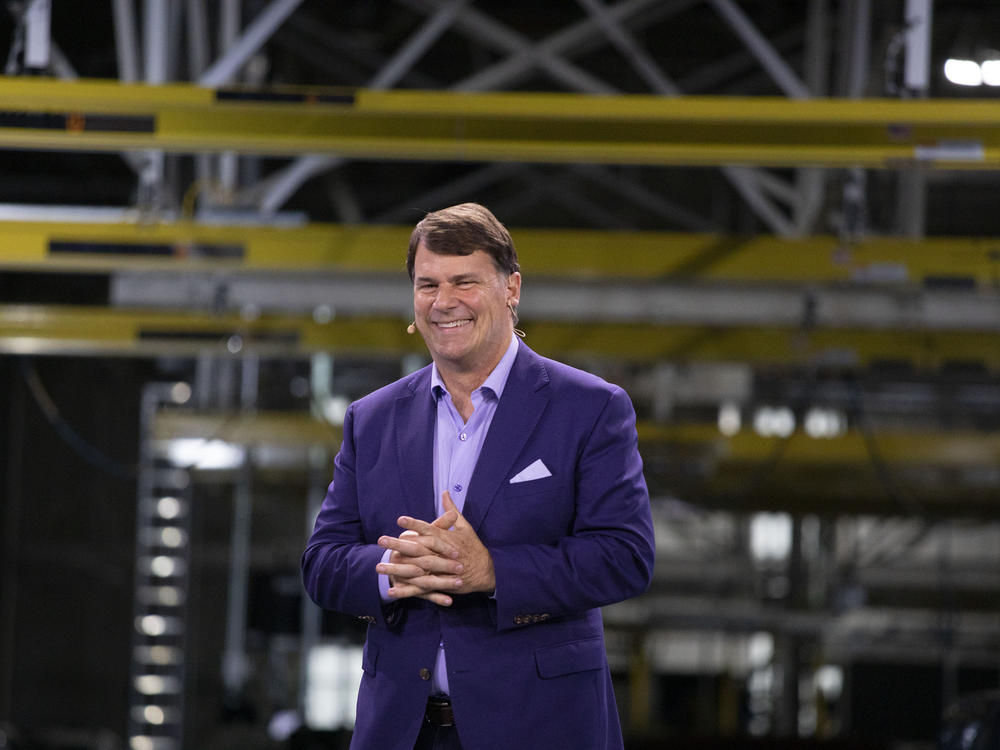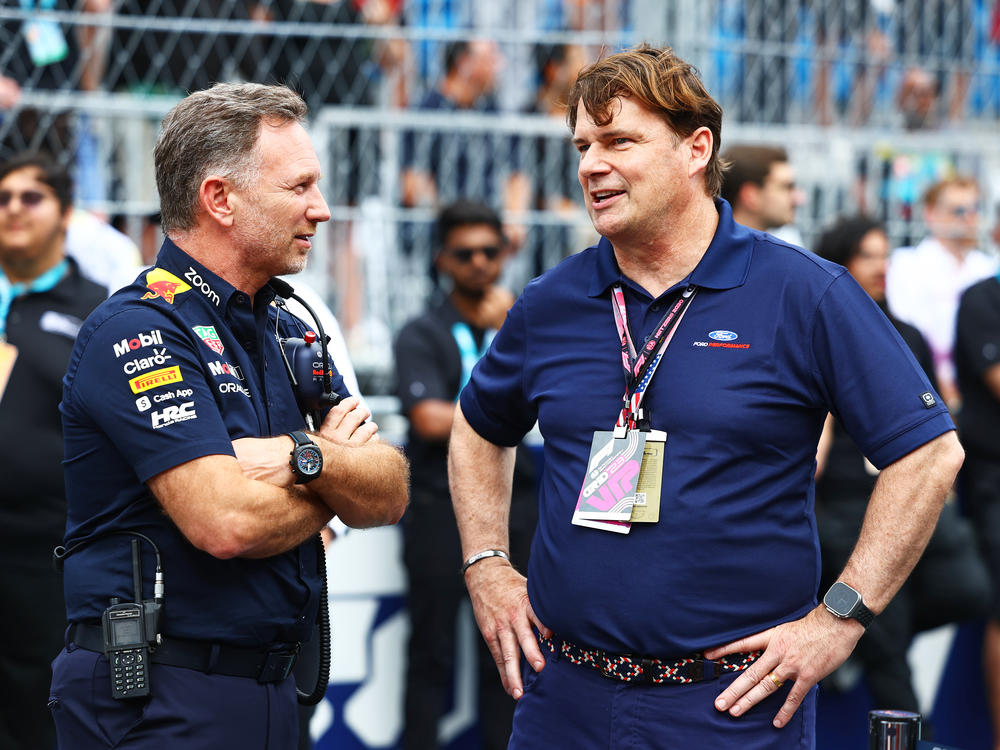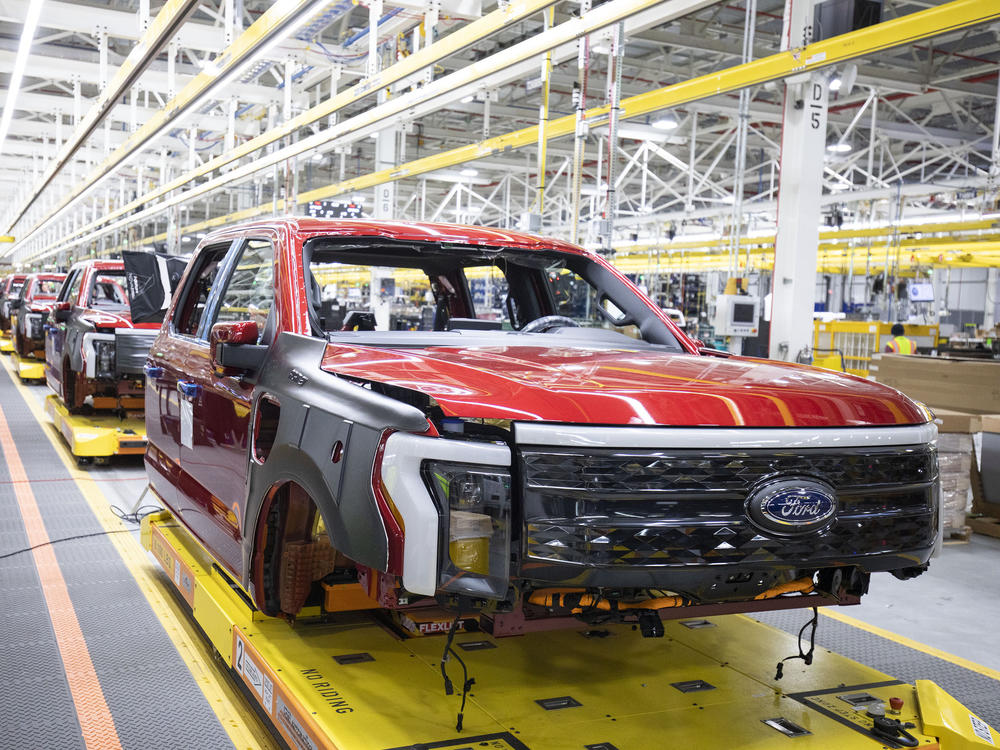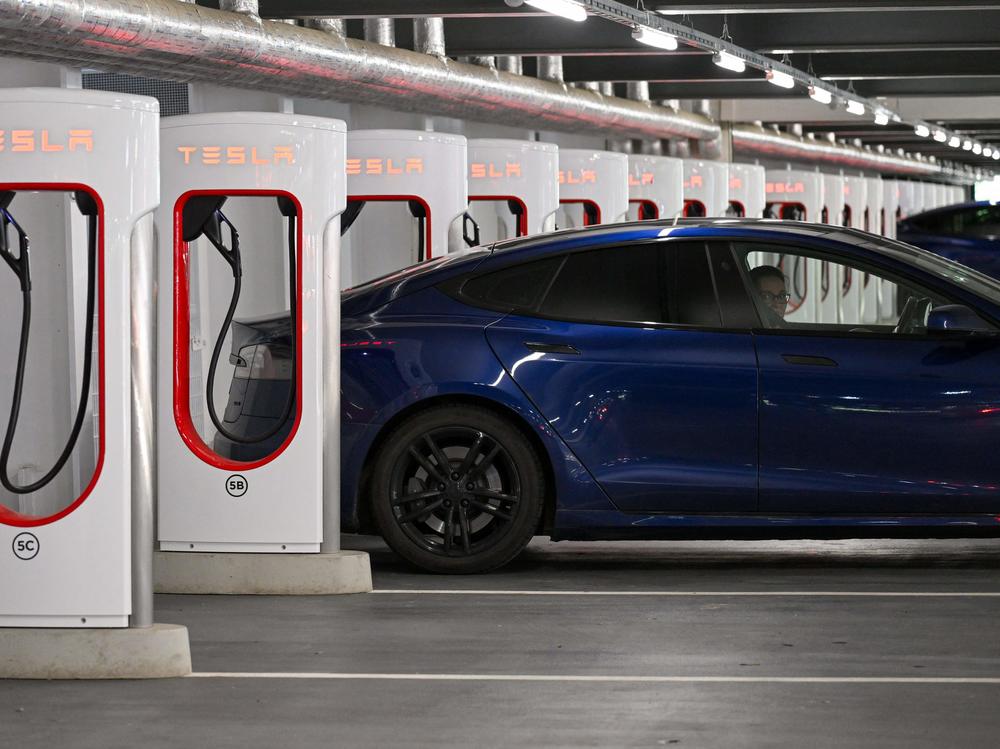Section Branding
Header Content
Ford is losing a lot of money in electric cars — but CEO Jim Farley is charging ahead
Primary Content
Updated August 12, 2023 at 10:12 AM ET
LAS VEGAS, Nev. — Jim Farley, the CEO of Ford, was pulling a U-turn in an electric vehicle. The reason? An elusive charging station.
"Where's the charger? This is always what happens to me," he said good-naturedly, as he turned his F-150 Lightning around, while following directions from his teenage son in the back seat. "Are they in that corner?"
But when it comes to Ford's plans to scale up electric vehicle production, Farley says, there's no U-turn at all.
Despite setbacks, the company that revolutionized the auto industry with the Model T is determined to be a major player in the electric revolution, too.
Competition is fierce. Tesla dominates the industry, both in the U.S. and globally, and legacy automakers are falling over themselves to figure out exactly how, and how quickly, they can catch up.
Ford planned to make EVs at a rate of 600,000 per year by the end of 2023, but Farley — who has led the company since 2020 — recently announced the company was moving that milestone into next year. A goal of 2 million by 2026 was delayed indefinitely. (Tesla, the EV leader, sold 1.3 million last year).
Ford is losing money on each EV it sells, so the reason for the shift in plans didn't seem to be a mystery.
The announcement made headlines and despite solid overall earnings, Ford shares dropped.
But in an interview with NPR, Farley denied there was any significant shift in strategy, calling the reasons for the delay "almost mechanical." He was at the tail end of a three-day EV road trip from northern California to Las Vegas.
"One of the biggest growth opportunities for us was our plant in Cologne, Germany, where we're going to launch the electric Explorer," Farley said, from behind the wheel of a red Lightning.
"And we weren't happy with thermal propagation — — the countermeasures around fire — with the vehicle," he added. "So we took a six-month delay to get the engineering right. That was the principal reason."
For the Explorer delay to have such a big impact suggests that Europe is playing an outsize role in Ford's evolving EV strategy. European governments are pushing automakers to go electric, and EVs are being adopted more quickly than in the U.S.
Farley insists that Ford is still fully committed to its EV expansion. He noted that even its lower target for 2023 — 400,000 EVs by the end of the year — is still up four-fold from 2022.
Ford's case for EVs
Legacy automakers have struggled to make EVs profitably. Ford lost a billion dollars on its EV unit last quarter.
The company loses money on every Ford Lightning it sells — and that was before it knocked thousands of dollars off the sticker price this summer, trying to keep up with a Tesla-triggered price war that's pulling EV prices down.
Meanwhile, Farley, a former Lexus executive who's spent 15 years at Ford, says the next generation of Ford EVs will be profitable. He's previously described those future vehicles as "radically simplified," using different battery chemistry and more efficient manufacturing.
So why would Ford want to scale up EVs in the near-term? Why not just wait and sell the vehicle it can make money on?
"For us to be the bestselling electric pickup is super important strategically," Farley said. "The first people who buy our first-generation electrics are going to be the first people to buy our second-generation electrics."
Ceding the electric pickup market to Rivian, Silverado or Ram without putting up a fight would put those profitable next-generation vehicles at a disadvantage.
And long-term, a lot could be on the line: The F-series pickup is the company's cash cow.
Electric vehicles are also attracting new buyers to Ford, according to Farley.
"Fifty percent of Lightning customers are new to us. 60% in [Mustang] Mach-E," Farley said. "We're getting customers we've never seen before. And that's very attractive for a company. You're either growing or shrinking ... we want to be a growing company."
Ford is hoping not just to get those new customers in a (profitable) second-generation vehicle, but also to sell them subscriptions and software upgrades for years to come.
But also hedging Ford's bets
Ford is investing billions in electric cars, but that doesn't suggest it's making a wholesale pivot.
Unlike many rivals, including GM, Volvo and Honda, Ford has never publicly committed to stop making gas- and diesel-powered vehicles altogether. And in the interview, Farley made the case for embracing more efficient gas- and diesel-powered vehicles as part of the fight against climate change — an argument that Toyota has also made.
Most climate advocates say that the climate crisis requires zero-emission vehicles, not incremental improvements, especially since vehicles have long lifespans and could emit carbon for decades.
Farley argued that for customers who drive large trucks, especially those who tow heavy loads for long distances, a wider range of options will be necessary.
"Hybrids, plug-ins, whatever it's going to be," Farley said. "We can't just look at it like it's internal combustion and all EV — there's all these possibilities in the middle."
This is a rhetorical shift for Ford, which just last year separated its EV development from its internal combustion engines — that is, its gas- and diesel- powered vehicles.
Ford split its operations into two businesses: Model e, focused on electric vehicles and digital experiences, and Ford Blue, focused on making gobs of money off traditional, gas- and diesel-powered vehicles. The profits from Ford Blue were meant to fund the future at Model e.
Hybrids barely featured in the announcement; they were only mentioned once to clarify that they fell under the Ford Blue umbrella.
But while they haven't been in the spotlight, hybrids have been selling well for Ford, both with the hybrid F-150 and the popular hybrid Maverick, a smaller and less expensive pickup.
Powering up remains a challenge
Even a short ride with Farley on his road trip spotlighted some of the practical challenges ahead as automakers prepare to get more Americans behind the wheel of an electric vehicle.
At a charging stop in Las Vegas, half the chargers weren't working, and the other half were occupied. Farley's F-150 had to wait.
This is, as Farley noted, "pretty normal." On his 1,000-mile road trip he encountered broken and fully occupied chargers repeatedly, a new experience for someone who was used to thinking about charging woes in the abstract.
Ford recently took an unprecedented step to address those shortfalls. Earlier this summer the company announced it was adopting Tesla's charging technology in exchange for giving Ford drivers access to Tesla's popular, reliable Supercharger network. That access will start in January.
"I'm sure glad we did the Tesla charging deal, that's all I can say," Farley grinned. "That was a good move."
Charging infrastructure — along with the supply of raw materials, the rapid growth of battery manufacturing and the need for an expanded electric grid — are major preoccupations for the auto world right now as everyone tries to figure out how quickly the industry can and will go electric.
Education — and a bit of persuasion — is a challenge, too
On his road trip, talking to Ford dealers and customers, as well as other drivers at charging points, Farley says he gained a deeper appreciation for less concrete challenges, too.
"This is new for a lot of people," he said.
Early adopters of EVs were committed to learn about how the technology worked. The next wave of buyers — people who are interested in EVs, but don't feel as strongly about them — have a lot of unanswered questions.
Farley described meeting a customer in Morgan Hill, Calif., who likes taking long trips and was debating whether to get a hybrid or an electric because of his uncertainty about the charging infrastructure
"'Mr. Fancy CEO, you tell me what to do,' " Farley recounted the customer as asking.
"I told him to buy an EV because it's the most expensive one," Farley joked, but went on to probe what the customer needed the car for. As it turns out, he often traveled between Lake Tahoe and San Francisco.
"Tahoe to San Francisco is the best-charging-infrastructure road trip in America. So I think you're good," Farley recalled telling him. "And I got on my phone and I show them where the charging places are, and he's like, 'That's cool.' "
Farley recounted the incident as an example of the long road Ford still faces in trying to convince more Americans to buy electric cars.
"It's actually not much different than the Model T, when we had to teach people to drive because they're coming off a horse," Farley said. "I think the industry has a huge education to do."
Copyright 2023 NPR. To see more, visit https://www.npr.org.
Correction
A previous version of this story said that Ford previously planned to sell 600,000 EVs this year. In fact, the stated goal was to hit an annual production rate of 600,000 EVs per year.




